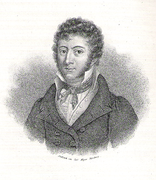John Field's Piano Nocturnes
Monday, September 11, 2017

The year 1812 brought the chaos of war to the European continent when Napoleon’s army went clear through Europe to Russia and reached Moscow. The outcome, as we know, was disastrous for the deuxième Grande Armée. It was the beginning of the end of Napoleonic rule in France and Europe.
But alongside these terrible wartime events, something small and wonderful arose: in St. Petersburg, a city spared from the war, the first piano nocturne in musical history came into being. The composer was the Irishman John Field (1782-1837), considered to be the pianistic phenomenon of his day. Field and Muzio Clementi found themselves in St. Petersburg on business, and after a longer stay there in 1803, Field simply stayed on. He made a living as a teacher and through regular concert performances. Field can be seen as one of the founders of the Russian school of piano playing. His most famous piano students were Alexandre Dubuque, Aleksander Gurilyov, Antoni Kątski, Charles Mayer, Maria Szymanowska, and Alexey Verstovsky.
As a pianist, Field’s playing was praised by his contemporaries because he could set himself apart from the mainstream. Descriptions of his playing by Mikhail Glinka, Johann Nepomuk Hummel, and Louis Spohr have survived. They emphasize Field’s differentiated touch in particular and his mode of playing that betrayed little body movement, which led to a special sound on the piano.
Field has inspired composers up to today. He especially influenced Frédéric Chopin, whose nocturnes have fixed in our minds what these character pieces of this genre sound like. Field’s nocturnes are characterized by songlike, calm melodies that span a broad range in the right hand with broad broken chords in the left hand as accompaniment. Fast runs interrupt the moderate flow of the pieces on rarely, and only a few have sections that really push forward. The nocturnes only sometimes show hints of variations or motivic transformations. Leading tones and suspensions on the downbeats yearn for resolution. They provide harmonic tension in the lyrical nocturnes.
Field did not only publish in Russia, such as with Dalmas. Elsewhere in Europe, Breitkopf & Härtel in Leipzig published a large number of his works, as did Clementi & Co. in London and Pacini and Richault & Momigny in Paris, which made him internationally and enduringly famous. Even after Field’s death, the number of his publications remained unusually high for a while in Germany.
Field wrote a total of eighteen nocturnes. Twelve sources with nocturnes by John Field are in the RISM database. Some of these are autograph manuscripts from Berlin (Staatsbibliothek zu Berlin, D-B) and Moscow (Glinka Museum, RUS-Mcm).
Image: John Field, circa 1835, by Carl Mayer. Via Wikimedia Commons.
Share Tweet EmailCategory: New at RISM

